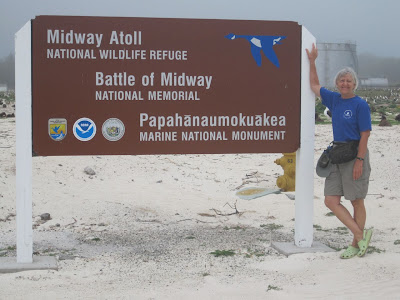Our planet Earth is getting warmer, causing the environmental problem we call
Global Warming. As Earth warms, the ice fields and glaciers melt, sending water into the oceans, causing the sea level to rise. How much is the sea level rising? Let's find out by using advanced laser and computer technology from a plane!
As with many difficult questions, it takes teamwork to get the answer. In this case, the team is made up of 2 private companies in Hawai`i and 3 departments of the federal government. The government team members are: United States Fish and Wildlife Service (
USFWS), US Geological Survey (
USGS), and National Oceanic and Atmospheric Administration (
NOAA.)
The picture above shows the private companies' side of the team, from left to right -- Robert Szabo, owner of
Szabo Aerospace from O`ahu, Thomas Pattison, owner of
Aerial Surveying, Inc. from Kailua-Kona on the Big Island of Hawai`i, and his son Kiel. Rob will fly his plane over Midway Atoll and nearby islands while Tom and Kiel take pictures using a technology called LiDAR.
LiDAR stands for Light Detection and Ranging. Let's get a look at the equipment while the plane is being fueled.

Kiel is welcoming us aboard Rob's Beechcraft Queen Air plane, nicknamed "Makalani," Hawaiian language for "eyes of the skies."
Inside the plane Kiel shows us the LiDAR equipment. Tom's company has modified the typical LiDAR rig, which weighs about 150 pounds and would be TOO much weight for the plane. Next to Kiel's left foot, the 3 silver-colored items are used to send out the laser from the plane. The laser reflects, or bounces, off the ground, returns to the plane, and that distance between the plane and ground is measured. Near Kiel's right foot is the black computer. The computer takes the laser data and calculates how high above sea level Midway's ground is. The computer also matches up the exact GPS location for each elevation measurement. And it will be correct to within 6
inches!!
The LiDAR data that Kiel, Tom and Rob are collecting will help answer the question, "Is the Sea Level Rising?" They can compare the maps they make today with maps from years ago to see how much the sea level has already come up. In the years ahead LiDAR can be used again to get new data. Having accurate knowledge about sea level will help all the people on Earth work together to solve the Global Warming problem.

Before we leave the plane, do you notice something blue on the plane's flight deck? When the hula doll dances, that tells Rob his plane's propeller engines are vibrating too much, and it's time to re-balance them. The pretty hula dancer has a job to do; she's part of the LiDAR team!



















































